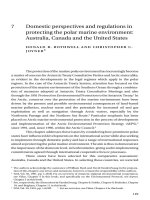developing domestic suppliers of electronics in vietnam the case study of canon vietnam’s strategy
Bạn đang xem bản rút gọn của tài liệu. Xem và tải ngay bản đầy đủ của tài liệu tại đây (484 KB, 29 trang )
0
DISSERTATION ABSTRACT
DEVELOPING DOMESTIC SUPPLIERS OF ELECTRONICS
IN VIETNAM: THE CASE STUDY OF
CANON VIETNAM’S STRATEGY
DOCTOR
OF BUSINESS ADMINISTRATION
BY
DBA. Candidate: TRAN XUANNGOC (RONALDO)
Scientific Adviser: Dr. EDUARDO T.BAGTANG
November, 2013
1
PREFACE
The general objective of this research is to find out the
theoretical reasons and practical evidence proving that the subsidiaries
company (Canon Vietnam) can influence on the development of local
suppliers’ capacity in order to promote the competitive advantages and
expand production. This study focuses on the following specific
contents: 1. Profile of the subsidiaries; 2. Autonomy of the
Subsidiaries; 3. Knowledge transfer strategies; 4. Competitive
advantages of the subsidiaries in Vietnam that can help develop local
suppliers; 5. Government policies towards developing local or domestic
suppliers’ capabilities.
CHAPTER I: INTRODUCTION
1.1. Background of the Study
In the manufacturing industry, Electronics industry is highly
representative for a developing country with a large population as
Vietnam. On the domestic market, the supply businesses in Vietnam are
of much weaker position than firms with foreign capital investment. In
terms of the value chain, the electronics industry of Vietnam mainly
assembles consumer products, focusing on the stages with low added
value. Very few companies produce detailed parts and accessories in
electronics. The assembling phase is mainly toward cheap labor, but
this is not possible advantage to gain a long-term health.
In the context of a group of electronics manufacturers closed
their plants in Vietnam, Canon Vietnam is a different case. For over 10
years, Canon Vietnam has been continuously expanded their
production, especially effectively building a network of local suppliers.
2
The topic of "Developing Domestic Suppliers of Electronics in
Vietnam: The case study of Canon Vietnam’s strategy" is meaningful
and useful for managers of multi-national companies in electronic field
when considering invest or now operating in Vietnam, the firms who
are now providing electronic domestic products the Vietnam
Policymakers.
1.2. Statement of the Problem
The recent state of electronics industry in Vietnam revealed
problems of competition of local suppliers with foreign suppliers.
Local suppliers of Vietnam are much weaker when compared to the
foreign suppliers.
Foreign investors import most of the components of the
electronic products; hence, the local suppliers can no longer compete
with them even with their cheap labor. This situation limits the
development of electronic industry in Vietnam.
1.3. Objectives of the Study
The overall objective of the study is to determine factors that can
help develop the capabilities of local or domestic suppliers in Vietnam.
1.4. Significance of the Study
Basically, multinational companies competing on the
international market have to deal with the changes of the local
environment. Building an efficient network of domestic suppliers by
transferring technology, developing existing relationships, helping
these suppliers involve in the value chain, improving the key elements
of local environment will help multinational companies promote their
3
strength. This is important for leaders to review and adjust the
orientation of the company.
At the national level, this study has an important meaning for
policy makers to understand the behavior of multinational companies
when they invest in the host country.
In fact, the industrial development policies of Vietnam
government are usually considered in a wide range of various types of
electronic companies. The role of multinational ones is underestimated.
Focusing on Canon Vietnam, this study will explore the role of a large
company in accelerating the development of domestic suppliers.
The results of this study will help domestic suppliers determine
needs of multinational companies, adjust their operation strategy,
improve capacity and competitiveness.
This study will be the important reference source for local
supporting industries.
Students and researchers can use this study as reference for
future studies.
CHAPTER II: REVIEW OF RELATED LITERATURE
AND STUDIES
2.1. Subsidiary in local environment
A multinational enterprise, or multinational corporation, is
defined as an enterprise that owns and control activities in different
countries, or as a major vehicle for the transfer of mobile resources
(technology, capital, management skills) to areas with immobile
complementary inputs (markets, raw materials, labor) (Buckley and
Casson, 1976; 1985). Market imperfections are factors explaining the
existence of multinational firms. Thus, the unique characteristic of the
4
multinational corporation is that it is engaged in multi-activities and in
the internal transfer of intermediate products outside its national
boundaries. To cope with the inherent volatility of the international
business environment, corporations need to adopt their strategies to
remain competitive and to develop simultaneously efficiency,
responsiveness and learning as strengths for success.
Although the static relationship between the subsidiary and its
local environment has been studied (Ghoshal and Nohria, 1989;
Rosenzweig and Nohria, 1995), and there have been empirical
researches on subsidiary expansion (Birkinshaw, 1998; Chang and
Rosenzweig, 1998), there has little consideration of the dynamic
question, say, the relationship between local environment changes and
subsidiary’s capability development. So far studies on local
environment-driven subsidiary evolution is still rather limited
(Birkinshaw and Hood, 1998a).
One of theoretical frameworks to identify the interaction of the
MNC and the host country is the diamond of competitive advantage of
nations (Porter, 1990). It is based on four country-specific determinants
and two external variables that are chance and government. The four
determinants are factor condition, consumer demand, suppliers, and
firm strategy and structure and nature of domestic rivalry. The four
determinants and the two external forces interact in the diamond, with
the nature of a country’s international competitiveness depending on
the type and quality of these interactions.
2.2. Local Suppliers of Electronics
With policies of reforming and calling for foreign investment,
Vietnam’s electronics industry has changed as many foreign companies
5
invested in component production for export and for foreign companies
operating in Vietnam. Products are like passive components, metal
cluster details, tubes, plastic, and parts of printers, computers. The
annual growth rate of the industry is 20-30% per year.
Factor affecting the electronics supporting industry in Vietnam
are summarized in the following table:
Strengths
- An abundant and fast-learning workforce and rather good
electronics staff
- Relatively-low labor costs
- A potential domestic market with a big population
- Good resources of materials to develop the electronic materials
technology
Weaknesses
- Limited production capacity
- Dependence on external materials providers
- Low competitiveness of products
- Lack of information on the world market
Opportunities
- A favorable position in the arc of East Asia, where to develop
electronic products of the world
- A completing law system in accordance with international
practices
Threats
- Stiff competition from China and ASEAN countries which have
a developed electronics industry
- Other competitors’ domination of the domestic market
6
Table 1: SWOT Analysis for the electronics industry of Vietnam
2.3. Factors affecting the development of Suppliers
a/ Role of government
Policies of Industry Development. In accordance with the
standpoint selection, the government will decide the national policies
relating to supplier industries say: localization, taxation on import and
semi-product and component production; science and technology
investment for supplier industries; laws, standards and specifications
for sectors and product lines in supplier industries… That these policies
enhance or inhibit the development of supplier industries depends on
the orientation of the government on this issue.
b/ The growth of multinational corporations
It is clear that the multinational corporations play a special role
in developing supplier industries. A traditional multinational
corporation is a firm in a country, which has branches abroad. Today,
multinational corporations mainly locate in a country and have foreign
partners. In general, the trend of multinational corporations is outward,
setting business strategy based on leveraging the competitive
advantages and market differentiation in each region and each country.
A special feature is that they standardize activities around the world in
all areas of business, but meet the different local demands when
necessary. This is made through alliances, technical agreements,
marketing agreements, research collaboration, and cooperate
development programs Multinational corporations’ investment is
usually followed by subsidiaries, auxiliary component manufacturers,
or core suppliers (Ernst D, 2004). Thus, multinational corporations not
7
only help modernize an economy but also create competitive
advantages for the country as well as social contributions.
However, suppliers might also become dependent on
multinational corporations because their products cannot be sold to
final consumers. Due to this, a downturn or recession often leads to the
bankruptcy of many suppliers. Governments often make policies to
reduce this dependence, however, this risk is unavoidable.
Thus, there are not only multinational corporations
manufacturing final products but also those supplying components and
accessories. Such suppliers master high technology and have
sustainable cooperation with large firms. They are usually important
sub-level suppliers of core or first-level suppliers. These suppliers
ensure to supply important parts and production phases in the
production network (Jones and Kierzkowski, 2005).
The development of electronics depends largely on electronics
multinational corporations worldwide. Although multinational
corporations have a production and distribution network in many
countries, strategies of their subsidiaries in each country have a huge
impact on the ability of component production at assembly sites.
(i) Multinational corporation with domestic orientation. In the
consumer industry, subsidiaries that produce bulky products such as
TVs, washing machines, air conditioners tend to strongly orient to the
domestic market. These corporations are often strongly motivated to
localize or use avaible infra-technology of the host country. In addition,
they tend to localize some stages such as molding, stamping, plating
Plants are often built at the sites of service supply because of frequent
changes in models and quick response from these stages.
8
(ii) Multinational corporation with global orientation. There are
more and more subsidiaries of multinational cooperation that take
advantage of production in the host country but direct to the world
market. Such multinational corporations are often found in audiovisual
industries (JBIC, 2004). Plants are built far from consumer market
partly because of slower increase in demand for these products than that
of consumer products. In addition, audio equipment and peripheral
electronics are relatively small in size, consume less material and very
popular all over the world, such as semiconductors, IC, resistors, wire
so that they can be easily transported anywhere in the world.
Thus, even if the target market is domestic or international,
multinational corporations are always motivated to localize components
with bulky size and heavy weight such as plastic cases, metal, casting,
molding tools. Branches towards local market have higher demand for
localization than ones with export orientation.
The Factors of subsidiary affect to the development of local
Suppliers: the profile of subsidiary; the autonomy of subsidiary; the
Knowledge transfer from Subsidiary company to local suppliers and
the competitive advantages of the subsidiary that can help develop local
suppliers.
9
2.4. Conceptual Framework
Input
1.Subsidiary company’s profilein
terms of:
1.1. Company culture
1.2. Organizational Structure
1.3. Operation Scale
1.4. Operation duration at the
local
1.5. Number of local suppliers
2. Autonomy of Subsidiary
company?
2.1. R&D
2.2. Financial Management
2.3. Marketing Strategy
2.4. Production Strategy
2.5. Production Process
2.6. Supplier Selection
3. Knowledge transfer from
Subsidiary company to local
suppliers?
3.1. Absorptive capacity
3.2. Responsiveness
3.3. "Hands-on" approach to
transfer knowledge
4. Competitive Advantages of
Subsidiary company?
4.1. Production Capacity
4.2. Capacity of Design and
Renewing
4.3. Technology of production
4.4.Qualifications of
Management
4.5. Price policy
5. Government policies towards
developing local or domestic
suppliers’ capabilities?
5.1. Protection of domestic
production (import tax…)
5.2. Priority to electronics
industry (incentives, production
tax…)
5.3. Central Management
Unit
5.4. Set up standards of
quality and components
5.5. Reducing the gap between
policies and implementation
Process
1. Assess the
CVN’s profile
2. Assess the
Autonomy of
the CVN
3. Assess the
Knowledge
transfer
strategies of the
CVN in the
following:
4. Assess the
competitive
advantages of
the CVN in
Vietnam
5. Assess the
Government
policies of
Vietnam
Output
!
!
!
!
!
!
!
!
!
!
Develope
d
Capabiliti
es of
Local
Suppliers
of
Electronic
s products
Feedback
10
CHAPTER III: METHODOLOGY
3.1. Research Design
The study has been carried out with two main steps of
qualitative research and quantitative research. In the qualitative
research, in-depth interview techniques combine with secondary data
collection at four local suppliers of Canon Vietnam (CVN). The
suppliers are different from origins and from development process of
becoming a supplier of CVN and are able to represent domestic
suppliers of CVN. This study has been conducted in May and June
2013. The results help to adjust the model and scale and to get new
discoveries, and since then to revise the questionnaire before the
quantitative research and model test.
The quantitative research has been conducted through survey
methods. Collected data has been used to assess the scale, test the
model as well as test the study hypotheses. It has been conducted since
July and August 2013. Multivariate regression, with SPSS 16, is used
to test the hypotheses.
The results of qualitative research: Based practical research,
theory and previous research, a research model consisting of 5
independent variables corresponding to the 5 factors affecting the
dependent variable - the capacity development of local suppliers is
proposed.
The five independent variables are: (1) Subsidiary company’s
profile; (2) Automy of Subsidiary company; (3) Knowledge transfer
from Subsidiary company to local suppliers; (4) Competitive
Advantages of Subsidiary company; (5) Government Policies.
11
3.2. Determination of sample size
Regarding sample size, by JF Hair et al, 1998, for the factor
analysis to explore the EFA sample size appropriate be at 10 times in
scale propositions. In this study, all 24 observed variables are used in
the factor analysis, so the sample size is 24 x 10 = 240 observations.
For multivariate regression, the minimum sample size is calculated by
the formula: 50 + 8 x m (m is the number of independent variables). In
this study, with five independent variables, the minimum sample size
is: 50 + 8 x 5 = 90 observations. Under both the above requirements,
the minimum sample size was determined 240 observations.
3.3. Sampling design and techniques
The sample in this study has chosen by non-probability method,
the judgment method in particular. Under this method, suppliers from
various types of ownership, products, operation time and regions in the
country have been selected.
On the subject of interview: There are four groups of
respondents, namely: Canon Vietnam manager, Canon Vietnam
employees, managers of local suppliers of Canon Vietnam, employees
of suppliers of canon.
3.4. Subject of the study
The study made used of the questionnaire-checklist method as
its primary data-gathering tool.
The questionnaire was pre tested to 5 of respondents, after
which, said responses were analyzed statistically using the Kuder-
Richardson Test of Reliability. This is to establish the validity and
reliability of the questionnaire. 250 sets of questionnaires were distributed
12
to the (6) managers of Cannon Vietnam and to the (100) employees of
Cannon Vietnam and to the (4) managers of the local suppliers and (140)
employees of the local suppliers of Cannon in Vietnam.
3.5. Research instrument
The questionnaire is designed clearly, easy to understand, with
specific instructions to interviewees to answer easily.
Selection of interviewees has based on the list of suppliers
provided by CVN and been followed by direct interviews. In addition,
to increase the number of responses, a number of complementary
methods such as delivering questionnaires at seminars, meetings,
customer conferences of CVN and suppliers have been made.
3.6. Data processing method
After receiving the questionnaire replies, the following steps,
including cleaning information, filtering the questionnaire, and
encoding the useful information in the questionnaire, data entry and
data analysis using SPSS 16 have been carried out.
Do statistics to describe collected data. Then take the steps (1)
test the value of the variables by EFA, (2) assess the level of
confidence Cronbach alpha, and (3) do multivariate regression
analysis.
3.7. Statistical treatment
- Test the value of the variables by EFA:
- Scale values test:
The scale is a preliminary assessment through Cronbach Alpha
coefficients.
13
Regression analysis:
- After concluding that the two variables have a linear
relationship, linear regression may be used to model the causal
relationship of these two variables.
- The research uses the multivariate regression method
ENTERS: All variables are taken into consideration in one time and
examine relevant statistical results.
CHAPTER IV: PRESENTATION, ANALYSIS, AND
INTERPRETATION OF RESULTS
4.1. Subsidiary company’s profile
For Canon
For Local Electronic
Suppliers
Subsidiary
Company’s
Profile
Mean
Descriptio
n
Mean
Description
Company culture
close as Vietnam
Company culture
3.17
Confused
3.75
Agree
Organizational
Structure Simple
3.17
Confused
3.75
Agree
Operation Scale
3.67
Agree
4.00
Agree
Operation duration
at the local
3.67
Agree
3.50
Agree
Number of local
suppliers
3.50
Agree
3.75
Agree
Table 7 – Assessment of the Subsidiary Profile by the Canon
Managers and the Local Electronic Supplier Managers
Table 7 reflects the factors that affect the development of the
local electronic suppliers under the subsidiary companies’ profile as
14
perceived by the managers of the Canon Vietnam and the domestic
suppliers. Of the five factors, the Company culture close as Vietnam
Company culture and the Organizational Structure Simple as factors
have a mean of 3.17 for Canon Vietnam managers and 3.75 for the
local electronic suppliers’ managers. Illustrates the different
assessments among different groups. The Canon Managers are still
confused about the roles of factors such as the Company culture close
as Vietnam Company culture and the Organizational Structure Simple
in the development of domestic suppliers whereas managers of local
electronics suppliers regard these factors as important. Canon Vietnam
Managers and the management of suppliers agree that those factors are
of great importance in the development of the local electronics
suppliers with average rating from 3:50 to 4.00.
For Canon
For Local Electronic
Suppliers
Subsidiary
Company’s Profile
Mean
Description
Mean
Description
Company culture
close as Vietnam
Company culture
2.68
Confused
3.78
Agree
Organizational
Structure Simple
2.82
Confused
3.28
Confused
Operation Scale
2.72
Confused
3.54
Agree
Operation duration
at the local
2.94
Confused
3.46
Confused
Number of local
suppliers
2.96
Confused
3.29
Confused
Table 8 – Assessment of the Subsidiary Profile by the Canon
Vietnam Employees and the Local Electronic Suppliers’ Employees
15
Table 8 shows how the employees of Canon and local electronics
suppers evaluate the subsidiary company's record. The results indicate
that for 5 factors, the employees of Canon are still confused with rating
from 2.68 to 2.96 while those of domestic suppliers approve that these
factors have impacts on the development of local electronics suppliers
with average rate from 3:50 to 4.00.
4.2. Autonomy of Subsidiary Company
For Canon
For Local Electronic
Suppliers
Subsidiary
Autonomy
Mean
Description
Mean
Description
R&D
4.00
Agree
4.00
Agree
Financial
Management
4.33
Agree
4.25
Agree
Marketing Strategy
4.67
Completely
Agree
4.25
Agree
Production Strategy
4.17
Agree
4.50
Completely
Agree
Production Process
4.17
Agree
4.50
Completely
Agree
Supplier Selection
4.33
Agree
4.50
Completely
Agree
Table 9 – Assessment of the Subsidiary’s Autonomy by the
Canon Managers and the Local Electronic Supplier Managers
Table 9 reflects factors affecting the development of local
electronics suppliers under the autonomy of subsidiaries with the
judgment of the management of the Canon and domestic suppliers. The
manager of Canon and domestic suppliers all agree or strongly agree
that R &D; Financial Management, Marketing Strategy, Production
Strategy, Production Process, Supplier Selection have tremendous
16
impacts on the development of local electronics suppliers with rating
from 4:00 to 4:50.
For Canon
For Local Electronic
Suppliers
Subsidiary
Autonomy
Mean
Description
Mean
Description
R&D
3.84
Agree
4.14
Agree
Financial
Management
3.99
Agree
4.19
Agree
Marketing Strategy
4.00
Agree
4.20
Agree
Production
Strategy
4.00
Agree
4.52
Completely
Agree
Production Process
4.08
Agree
4.60
Completely
Agree
Supplier Selection
4.16
Agree
4.80
Completely
Agree
Table 10 – Assessment of the Subsidiary’s Autonomy by the
Canon Vietnam Employees and the Local Electronic Suppliers’
Employees
Table 10 reflects the factors affecting the development of the
electronics suppliers in the local autonomy of subsidiaries according to
the staff of Canon and domestic suppliers. The table above shows the
Canon staff and local providers consent or strongly agree that R &D;
Financial Management, Marketing Strategy, Production Strategy,
Production Process, Supplier Selection have an important influence on
the development of local suppliers with the rates from 3.84 to 4.80.
17
4.3. Knowledge transfer from Subsidiary company to local
suppliers
Table 12 is the evaluation of the management of the Canon and
the domestic supplier about knowledge transfer factors affecting the
development of local electronics suppliers. According to the results,
Canon managers are in favor of the fact that Absorptive capacity,
Responsiveness, "Hands-on" Approach to transfer knowledge have an
important effects on the development of local electronics suppliers with
rating from 4.00 to 4.33. Meanwhile, the management of the domestic
suppliers impact consider these factors to be very important with the
assessment level from 4.50 to 4.75.
For Canon
For Local Electronic
Suppliers
Knowledge transfer
Mean
Description
Mean
Description
Absorptive capacity
4.00
Agree
4.75
Completely
Agree
Responsiveness
4.00
Agree
4.50
Completely
Agree
"Hands-on"
approach to transfer
knowledge
4.33
Agree
4.50
Completely
Agree
Table 12 – Assessment of the Knowledge transfer by the
Canon Managers and the Local Electronic Supplier Managers
For Canon
For Local Electronic
Suppliers
Knowledge transfer
Mean
Description
Mean
Description
Absorptive capacity
4.04
Agree
4.16
Agree
Responsiveness
3.68
Agree
3.63
Agree
"Hands-on" approach
to transfer knowledge
4.04
Agree
4.18
Agree
18
Table 13 – Assessment of the Knowledge transfer by the Canon
Vietnam Employees and the Local Electronic Suppliers’ Employees
Table 13 represents the evaluation of the Canon staff and local
providers of knowledge transfer factors affecting the development of
local electronics suppliers. According to the results, research groups
have unanimous approval. They all agree that the Absorptive capacity,
Responsiveness, "Hands-on" Approach to knowledge transfer are
important factors for the capacity development of local suppliers with
rating from 3.63 to 4:18.
4.4. Competitive Advantages of Subsidiary Company
For Canon
For Local Electronic
Suppliers
Competitive
Advantages
Mean
Description
Mean
Description
Production Capacity
3.38
Confused
4.00
Agree
Capacity of Design
and Renewing
4.00
Agree
4.25
Agree
Technology of
production
4.67
Completely
Agree
4.50
Completely
Agree
Qualifications of
Management
4.67
Completely
Agree
5.00
Completely
Agree
Price policy
(Acceptable price)
4.17
Agree
4.75
Completely
Agree
Table 14 – Assessment of the Competitive Advantages by the
Canon Managers and the Local Electronic Supplier Managers
Table 14 indicates factors affecting the development of local
electronics suppliers according to the competitiveness of subsidiary
companies under the judgment of Canon and local suppliers' managers.
19
The results show that Canon managers are wondering about the factors
affecting Production Capacity with the rating of 3.38 but the
management of local businesses agrees with 4:00. The remaining
elements such as Capacity of Design and Renewing; Technology of
production; Qualifications of Management; Price policy are accepted or
completely accepted to have enormous influence on the development of
domestic suppliers with the rates from 4:00 to 5:00.
For Canon
For Local Electronic
Suppliers
Competitive
Advantages
Mean
Description
Mean
Description
Production Capacity
4.01
Agree
4.20
Agree
Capacity of Design
and Renewing
3.86
Agree
4.55
Completely
Agree
Technology of
production
4.04
Agree
4.77
Completely
Agree
Qualifications of
Management
4.07
Agree
4.70
Completely
Agree
Price policy
(Acceptable price)
4.10
Agree
4.34
Agree
Table 15 – Assessment of the Competitive Advantages by the Canon
Vietnam Employees and the Local Electronic Suppliers’ Employees
Table 15 shows how Canon and electronics suppliers' staff assess
competitive factors, which affect the development of local electronics
suppliers. In this evaluation, research groups are unanimous or totally
unanimous. Production Capacity factors; Capacity of Design and
Renewing; Technology of production; Qualifications of Management;
Price policy (Acceptable price) are said to have fundamental
importance on the capacity development of domestic suppliers with
reviews from 3.86 to 4.77.
20
4.5. Government Policies
Table 17 demonstrates the evaluation of the Canon and the
management of domestic suppliers about government policies, which
influence the development of local electronics suppliers. The results
from Table 9 show that Canon managers and local supply businesses
agree and strongly agree with the high rating from 3.67 to 4.75. The
Protection of Domestic production factors (import tax ), Priority to
electronics industry (Incentives, production tax ); Central
Management Unit; Set up standards of quality and components;
Reducing the gap between policies and Implementation are considered
as important factors for the development of domestic suppliers with
level of agreement or complete agreement.
For Canon
For Local Electronic
Suppliers
Government
Policies
Mean
Description
Mean
Description
Protection of
domestic production
(import tax…)
4.00
Agree
4.75
Completely
Agree
Priority to
electronics industry
(incentives,
production tax…)
4.50
Completely
Agree
4.50
Completely
Agree
Central Management
Unit
3.67
Agree
3.75
Completely
Agree
Set up standards of
quality and
components
4.50
Completely
Agree
4.25
Agree
Reducing the gap
between policies and
implementation
4.17
Agree
4.50
Completely
Agree
Table 17 – Assessment of the Government Policies by the
Canon Managers and the Local Electronic Supplier Managers
21
For Canon
For Local Electronic
Suppliers
Government
Policies
Mean
Descriptio
n
Mean
Description
Protection of
domestic
production (import
tax…)
3.61
Agree
3.77
Agree
Priority to
electronics industry
(incentives,
production tax…)
3.40
Confused
4.14
Agree
Central
Management Unit
3.49
Confused
3.78
Agree
Set up standards of
quality and
components
3.56
Agree
4.24
Agree
Reducing the gap
between policies
and implementation
3.63
Agree
4.24
Agree
Table 18 – Assessment of the Government Policies by the Canon Vietnam
Employees and the Local Electronic Suppliers’ Employees
Table 18 indicates how the staff of Canon and domestic suppliers
evaluate the way government policies effect the development of local
electronics suppliers. According to the results, in comparison with
managers, employees of Canon and local supply businesses reckon that
these factors have lower impacts. Employees of local suppliers agree
that Protection of Domestic production factors (import tax ), Priority
to electronics industry (Incentives, production tax ); Central
22
Management Unit; Set up standards of quality and components;
Reducing the gap between policies and Implementation have impacts
on the development of local suppliers with ratings from 3.77 to 4:24
whereas Canon employees are puzzled about how Priority (Incentives,
production tax ) influences the electronics industry at 3:40, Central
Management Unit factor at 3:49. The other factors are agreed with
ratings from 3:56 to 3.63.
4.6. Analysis and interpretation of data
Model 4: The capacity development of local suppliers (DCLS) is
influenced by the variables Competitive Advantages (CA), Knowledge
Transfer (KT), Autonomy of Company (AC) and Government Policies
(GP). Adjusted R Square is adjusted 0.521 that shows the variables in
the model explain only 52.1%. F test and t-test both have significance
< 0.05, so the model is statistically significant.
However, in the four models above, Model 4 has Adjusted R
Square of 0.521, the highest among all models, VIF standards are less
than 10, multicollinearity phenomenon of the variables in the model,
although exists, is at a low level. Therefore, Model 4 is selected.
The model reflecting the capacity development of the local
suppliers in electronics industry is as follows:
DCLS = 0.984 + 0.302 * (KT) + 0.282 * (CA) + 0.130 * (AC)
+ 0.1 * (GP) + ε
In the four factors affecting the capacity development of the
local suppliers in electronics industry, Knowledge Transfer (KT) has
23
the most influence by the regression coefficient of 0.302. The factor
that has the second influence is Competitive Advantages (CA) with the
regression coefficient of 0.282. The third-ranked factor is Autonomy
Company (AC) with the regression coefficient of 0.130. And the forth-
ranked factor is Government Policies (GP) with the regression
coefficient of 0.1.
CHAPTER V: SUMMARY, CONCLUSIONS, AND
RECOMMENDATIONS
5.1. Summary
In this study Canon Vietnam and the local electronic suppliers
are the main subjects. In the first chapter the authors has claimed the
research hypothesis based on the context and objectives of the study.
Chapter 2 is a collection of external and internal research papers related
to the research model. Research methodology and data sources are
presented in Chapter 3. Case study with interviews and questionnaires
were used. Results are calculated, processed and tested by SPSS
statistical software.
Chapter 4 shows the evaluation and discussion results. The
affecting factors and the level of impact on the development capacity of
local providers have been identified and demonstrated.
5.2. Conclusions
Canon Vietnam has been adjusting their local development
strategy, especially has built a network of local suppliers.
24
The network of local suppliers of Canon is considered strong and
sustainable with long-term business commitment in Vietnam made by
Canon.
Subsidiary of Canon plays a significant role in the development
of these local suppliers and vice versa, that is the improvement of local
supplier network helps Canon Vietnam to increase competitiveness
against its rivals.
5.3. Recommendations
5.3.1. Recommendations for Businesses
5.3.1.1. Changing perception of the managers and staff of local
suppliers
- Producing under the direction of specialization
- Compliance international standards as follows:
+/ IEEE: Criteria of Institute of Electrical and Electronics
Engineers
+/ EIA: Electronic Industries Alliance
- Be active in product selection and market searching
5.3.1.2. Initiative in selecting and creating linkages with other
enterprises
General trend of the world today is the more detailed international
labor division. Therefore, only when diversifying joint ventures,
investment cooperation that the new Vietnamese firms became a link in the
global production chain. So far we only focus on joint venture through
capital contributions, processing simple products. It is the time for us to
seriously consider ventures of strategic partnerships, satellite companies,
copyright transference and trademark.









